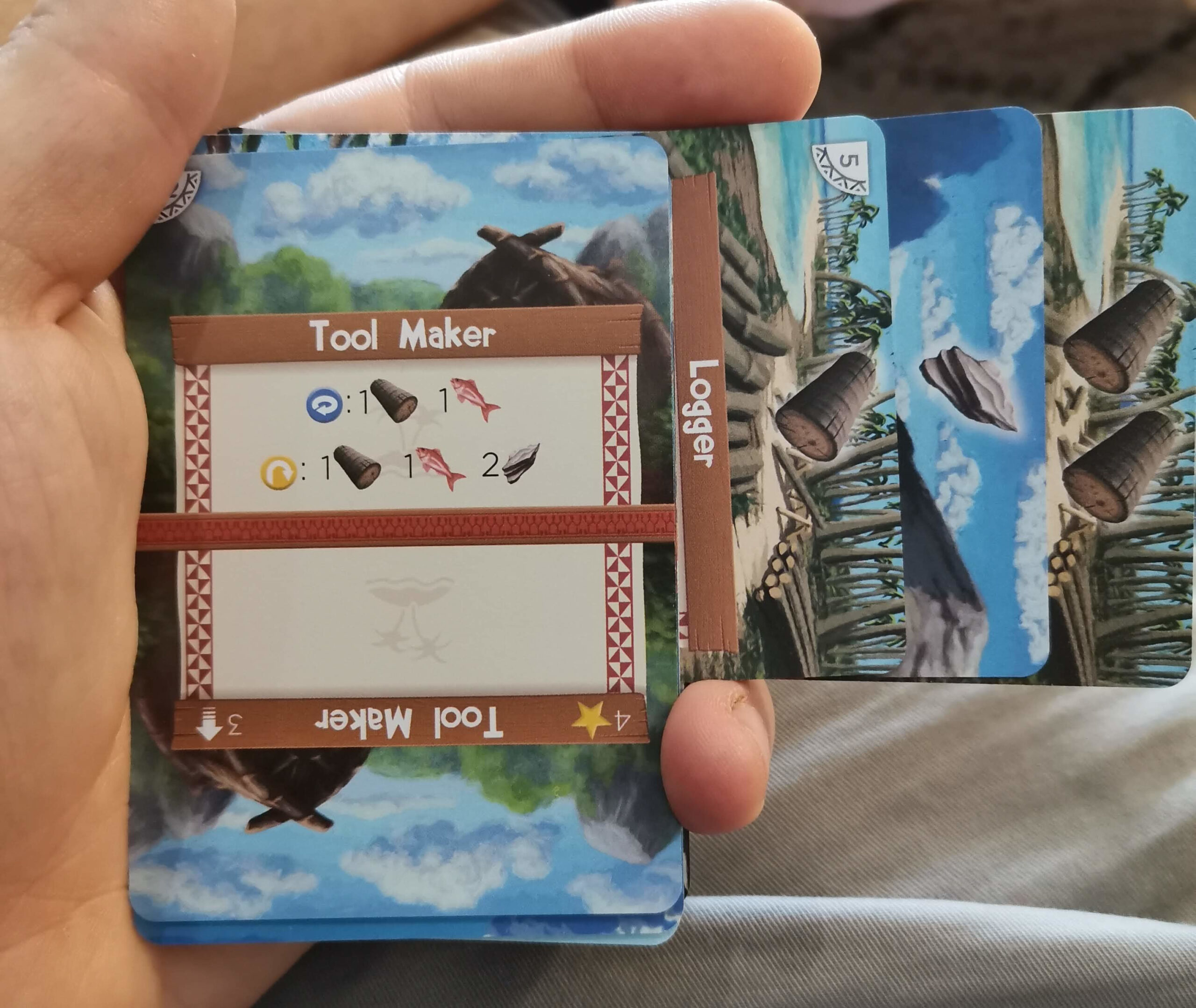In a change from my usual style here, where I review games that tend to cover an entire table, today we’re going to look at one that fits in the palm of your hand. Jon Mietling‘s 2018 game Palm Island comprises of just 17 cards, but can it contain a game worth buying in such a small package? Let’s find out.

What’s In The Box?
There’s not much of a box to speak of, as you might expect with a game that’s designed to fit in one hand. There are a few different versions available, but the one I have comes with plastic cards, a magnetic clasp box, and a small faux-leather wallet with the Palm Island logo on.
There are two sets of the cards in the box, so you can play some of the two player games, which are mostly just direct competition for points. Along with these there are a few cards with rules and feats reminders, and a small instruction booklet.
The components are really nice. I love the magnetic box, and the little wallet could genuinely be used to take a copy in your pocket anywhere, anytime. The plastic cards in this version are divisive; some people love them, some hate them. I fall into the former group. I like knowing these will never wear out or get sweaty or dirty from being clasped in someone’s hand. The downside of the plastic is that it makes them pretty slippery. Great for shuffling and slotting cards into the deck, hard to keep hold of at times.
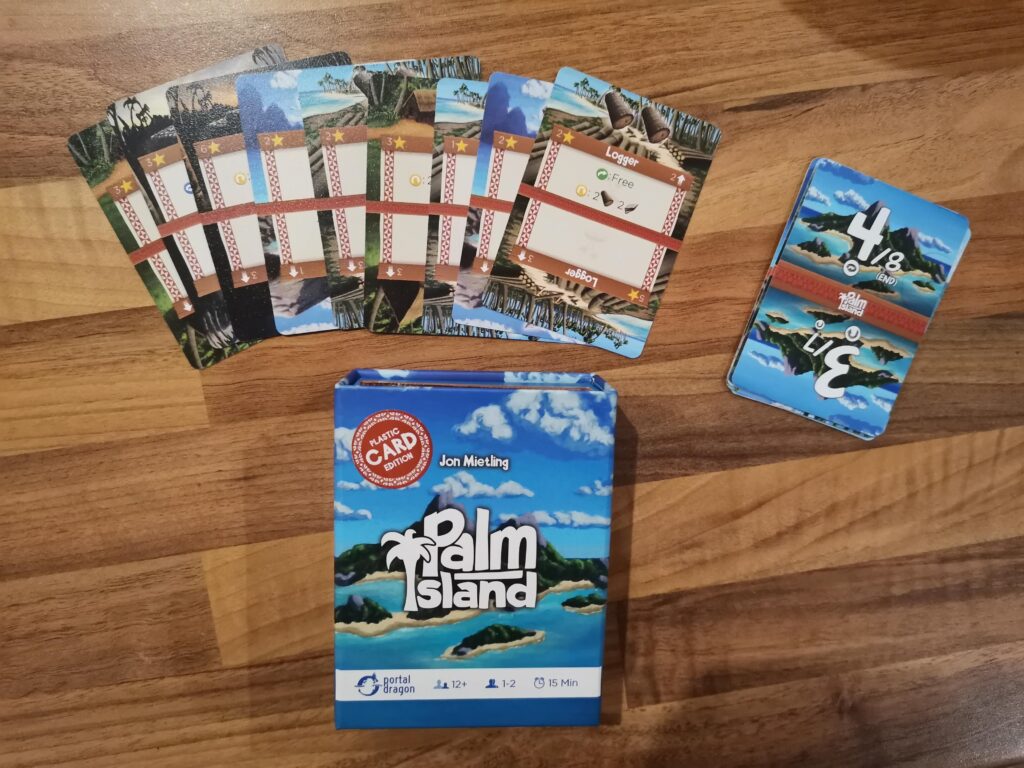
How Does It Play?
Palm island is essentially a resource management game, mixed with city-building, in a quite abstracted way. The premise is you’re put in charge of a budding island, and need to build it to be thriving.
To set up the game you set the round marker card to one side, and then shuffle the deck. There’s a mark in the corner of every card to help you orient it the right way. The round marker card goes at the back, then you take the assembled deck in your non-dominant hand, and you’re ready to go.
Each of the cards represents a building in your fledgling island community. The aim of the game is to score as many points as possible over eight rounds, and the way you do that is by upgrading the buildings. To upgrade a building, you need resources, so where do you get those resources? From the cards themselves.
Turn…
Each of the cards that can be used as resources have a number of symbols on the top of them, representing one or more of the different resources in the game: fish, logs or stone. To store a card’s resources you check the card to see if there’s a cost to bank it, pay the cost if so (more late on paying), and then turn the card 90 degrees clockwise (assuming you’re holding the deck in your left hand. You place that card – still rotated – at the back of the the deck, and the resources you’ve banked are now visible to the side. If you were to bank a second card, the same thing happens but the card is slid slightly to the right, so you can see all of your resources.
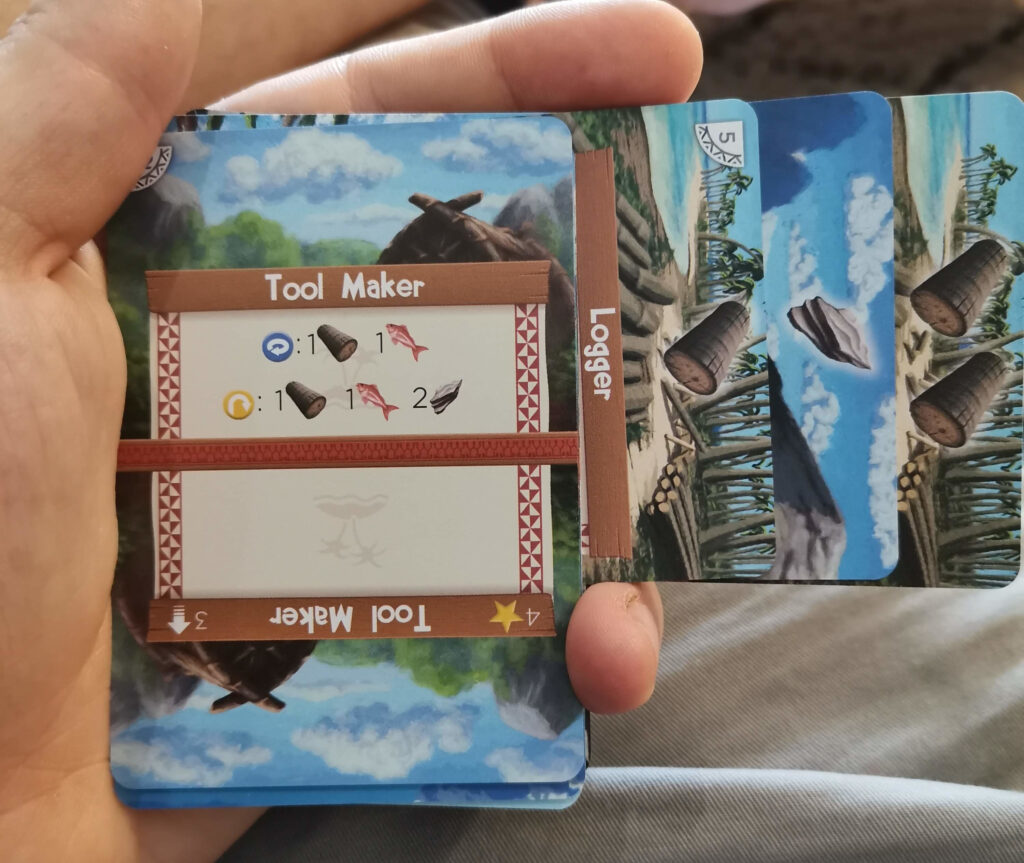
Any time a card is either discarded or upgraded, it gets put on the back of the deck, and so the resources slowly make their way forwards. If they ever reach the front of the deck, they’re discarded to the back, so you need to plan to spend them.
…Turn…
For each turn (see what I did there?) you look at the top card on the deck and decide what you want to do with it. You;ll either bank it as a resource, or upgrade it. Banking some resources when the cards have been upgraded might mean that you have to spend one to bank three for example. Usually these banked resources though are spent on upgrades.
…And Turn Again
Each card in Palm Island has four parts. The cards are double-sided, and each side has a top and bottom half. Shown on each card is the cost to upgrade it, and the action you carry out when you upgrade it. The action will either rotate it 180 degrees, so the top is now the bottom and vice-versa, or to flip it over. If it costs resources to do this, those resources are just rotated back upright wherever they are in the deck.
If you decide not to use the card on the top of the deck, you can look at the one beneath it and play that one instead, but if you don’t want to play either, the top one is discarded to the back of the deck. Once you’ve got through the whole deck, the round indicator card comes to the top. It has an arrow to show whether to rotate or flip it so that the next number shows, and it goes to the back of the deck. Once the eighth round is done, it’s game over. You add up the stars shown on your upgraded cards, and that’s your final score.
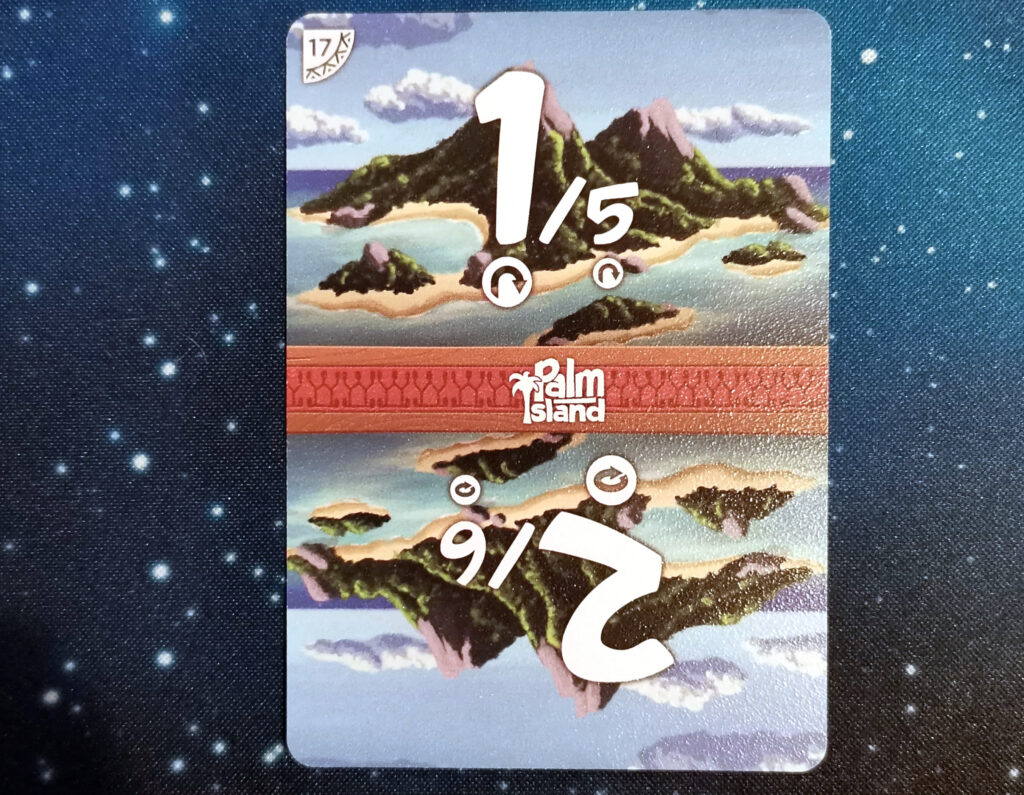
Getting certain scores or winning with certain conditions can unlock feats, which give you different ways to play future games. Not really a legacy game, but certainly enough to keep things fresh for a while and add a challenge,
Final Thoughts
Palm Island packs in way more game than it has any right to. It’s only a few cards, but really manages to capture that feeling that bigger games can, one of producing resources, growing your town, upgrading and keeping things balanced. It’s hard though, really pretty difficult to score well in. It takes a couple of rounds just to learn the order of the cards that are coming up, so you can start planning which resources you’re going to bank, and what you’re going to spend them on.
Initially it can feel like an unfortunately shuffled deck is going to ruin any chance of doing well, but with a few plays under your belt you start to realise that you can influence the order, and make things work for you. Don’t like that those two cards are right next to one another? Hold one, and play the one underneath, then do the same thing again, and now you’ve got a card gap between them. And it’s small moves like that, that can make all the difference.
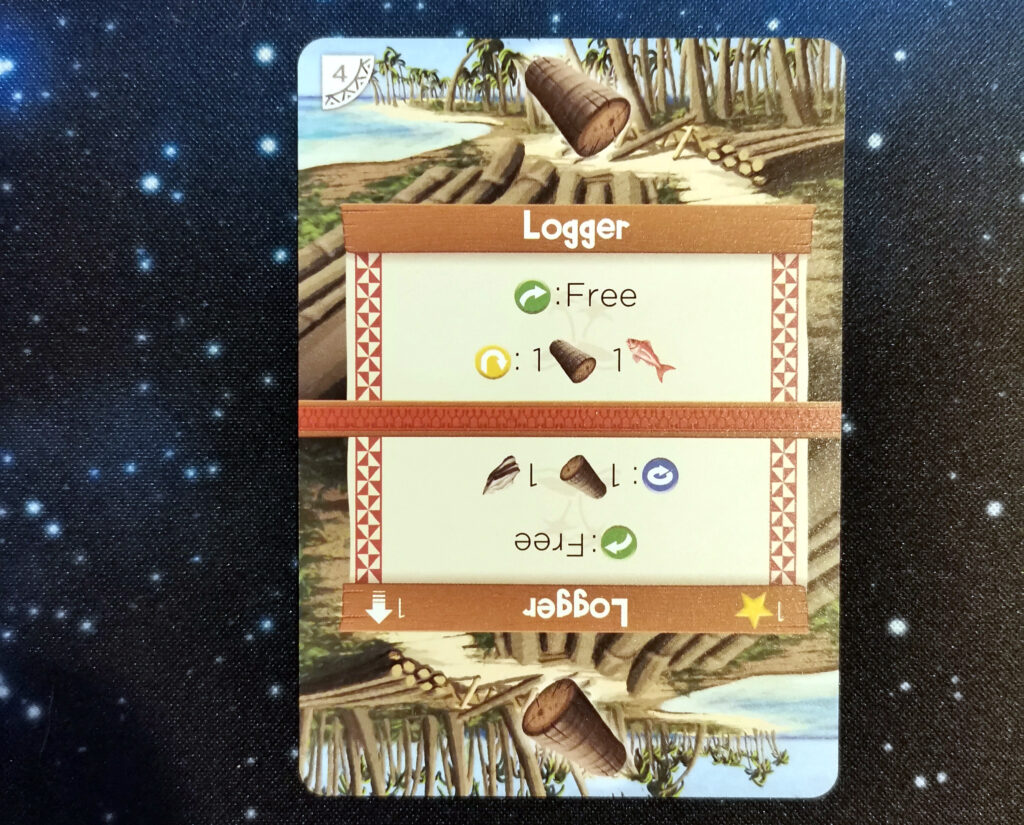
It’s such a satisfying game, it makes me smile and feel cosy just to play. There are so few card and board games that you can curl up in a big chair and play, but this is one. And it doesn’t feel like a compromise to play it, it’s not a case of “I want to play in bed, I’ll compromise with something light and a bit rubbish“, you can play a thinky, clever game – anywhere. It even comes with little divider cards, so you can save your game at any point to continue later. You might wonder why you’d bother with that, a full game only takes 15 minutes. But remember that you can take this anywhere, so you may have started a game while waiting for the kids to come out of school, or waiting at the dentist before you get called in, so it’s a small but really welcome addition.
A Slippery Customer
The plastic cards are awkward at first to just keep hold of. There’s very little friction between them and they feel slippery together. It’s a double-edged blade though, as despite them being harder to hold than standard cards, they’re also really easy to shuffle, and really easy to slip them around when you’re spending resources or moving cards to the back of the deck. I have lost a game I was going to score well on however (no, really) when my deck essentially exploded when I sneezed, but that’s only once in dozens of plays.
The reason I’m highlighting it is just to make anyone aware of the potential problem if they’re thinking of picking up the plastic card version. If you’ve got small hands or any kind of problems with your hands or motor control, it could be a problem. For the rest of us though, it’s just a case of playing a few times until you get the feel for it.
In closing, given the fact this will barely take up any space in your collection, if you can find it for a reasonable price and have lots of small windows to play something, I think you should definitely pick up Palm Island. There are lots of versions around, so check which one you’re getting and what it’s made of. The feats, additional cards, and two-player modes – both competitive and co-operative – give the game a longer lifespan than you’d expect too. An exceptionally well-designed and implemented little game.
